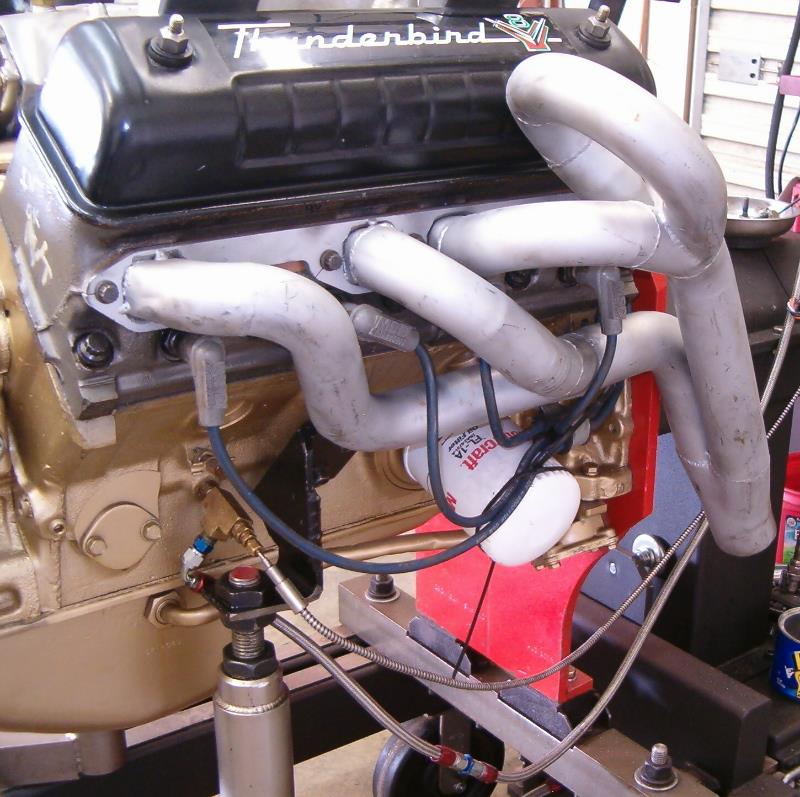|
By raybaker1 - 12 Years Ago
|
I have a 1955 Ford Crown Vic with a "59 or 60" 292 engine. I am wanting to install a aftermarket manual oil gauge with oil lines going directly to the new gauge. I currently use the stock electric sending unit that delivers the signal to the oil light in the dash and want to keep this working.
I want to keep the stock oil light working but install the manual line also. Listed below is my questions that I have.
a. Can I use the existing electric oil sensor on the forward - driver side of the block to also connect the oil line to my mechanical gauge? If so will I need to purchase a combination electric/manual oil sensor?
b. Is there more then one location on the 292 block where I can instal a second oil sensor?
Thank,
Ray
|
|
By slick56 - 12 Years Ago
|
Ray, in line with the oil filter on the left side of the engine heading forward, there are 3 plugs that tap into the oil gallery. Any one of these can be used for an oil pressure guage, but probably the middle one would be the best, as the next one back is close to the engine mount.
The pic below is where a tee has been put in to run oil to the rocker gear on my 56 engine, but the 1960 292 i have spare is not tapped in this position.
you could do similar and put the guage adapter in place of the copper tube,
but i would just screw the adapter into another plug hole.
|
|
By dbird - 12 Years Ago
|
Your gauge should come with an i/8 inch pipe fitting adapter to the tube going to the gauge. The easiest way is to go to the nearest hardware store, get a 1/8 nipple and tee, brass looks best, but anything will work. Take out your current sender and screw it in one part of the tee, the nipple in another, and the gauge fitting in the third. You might want to experiment to see which configuration works the best for you. Tighten everything down and screw the nipple in the hole the sender out of, attach the sender wire and the gauge tube and it should all work.
Good luck,
Don
|
|
By rick55 - 12 Years Ago
|
|
Don, from my experience, is partly correct. The gauges do come with fittings to 1/8" BSP or gas fittings. The blocks are drilled and fitted with 1/4" BSP plugs. You will need a 1/4" gas tee piece and a 1/4" - 1/8" reducing nipple. Personally I would use an e!ectric gauge as most mecvhanical gauge fitting Kits these days use nylon lines which can fail if they contact or come too close to the exhaust.
|
|
By 62f250 - 12 Years Ago
|
|
You can buy 1/8 inch copper tubing in rolls at a parts store in varying lengths. i would recommend using a mechanical gauge plumbed with copper tubing. I hooked a mechanical up in my dd f150 and left the factory electric gauge hooked up as well and according to the electrical gauge it claimed i had awesome oil pressure but the mechanical varied from 40 psi to 0 before the electric one moved
|
|
By The Master Cylinder - 12 Years Ago
|
|
rick55 (12/18/2013)
Kits these days use nylon lines which can fail if they contact or come too close to the exhaust.
Copper tubing is readily available but you can also get brained S/S lines and even Kevlar oil lines these days.
http://www.speedwaymotors.com/Shop/Oiling-System-Engine-Oil-Pressure-Gauge-Tubes/12.html
|
|
By vntgtrk - 12 Years Ago
|
|
I'll just add that compression fittings are available for copper tubing so you don't have to do any fancy flaring. And ditto the electric gauges. I'm an old f@rt and just don't trust 'em
|
|
By 56_Fairlane - 12 Years Ago
|
|
I have searched endlessly but what in the world are "brained S/S lines"?
|
|
By zheimers - 12 Years Ago
|
|
Braided
|
|
By zheimers - 12 Years Ago
|
|
Stainless steel
|
|
By Ted - 12 Years Ago
|
Here’s a picture of a braided steel line being used for oil pressure. At the same connection is also an oil temperature sending probe.

|
|
By Don Sandefur - 11 Years Ago
|
Ray: When you install the oil pressure gauge that uses an oil line, I advise that you install a separate gauge under the dash to read [pounds of pressure and retain your existing "idiot light" because the light draws your attention immediately when oil pressure goes down. To retain both, simply install a 1/4" pipe T into your block where the oil pressure sender comes out, then screw the oil sender into the T. Then screw in a 1/4 to 1/8 inch pipe reducer into th remaining T opening. Your new oil gauge should have a 1/8" (or 1/16) connector to the tubing that goes to your gauge. The other and of this connector is 1/8" pipe thread to scew into the T that you installed. I prefer copper tubing instead of nylon, an it should have a circular loop anywhere along its length to absorb vibration. You end upwith both a gauge to minitor prssure and a warning light to alert you immediately in case of oil pressure failure.
Don
|